F
You are using an out of date browser. It may not display this or other websites correctly.
You should upgrade or use an alternative browser.
You should upgrade or use an alternative browser.
- Status
- Not open for further replies.
M
MeteorWayne
Guest
F
FreeThinkingAnarchist
Guest
From the sun's frame of reference, can we see the planets' movement? For example, the earth orbits the sun at 29.658 km/s. If we observe the earth through a telescope from the Sun, will we detect the 28km/s speed? I guess the 28 km distance may be too small to detect any movement when considering the 92 million miles distance between earth and Sun.
M
MeteorWayne
Guest
BTW, that speed is just the average orbital speed of the earth. It's faster in January when we are closer to the sun, and slower in July when we are the furthest away.
Yes we can detect the earth's motion by observing the sun againt the background stars. For example, right now the sun is in the constellation Gemini. 6 months from now it will will be in the constellation Sagittarius when we are on the other side of the sun.
From the sun, the earth would be seen to move against the background stars about 1 degree per day.
Wayne
Yes we can detect the earth's motion by observing the sun againt the background stars. For example, right now the sun is in the constellation Gemini. 6 months from now it will will be in the constellation Sagittarius when we are on the other side of the sun.
From the sun, the earth would be seen to move against the background stars about 1 degree per day.
Wayne
3
3488
Guest
Very true Wayne & to FreeThinkingAnarchist, I will research this for you & will come up with some information as to where the planets appear in the Sun's sky today: Wednesday 1st July 2009.
As Wayne correctly says, the Earth at the moment will appear in Sagittarius as the Sun currently is in front of Gemini & will be very bright, approx magnitude -2 (worth mentioning all of the planets will appear at full phase from the Sun, obviously).
I quite like this sort of thing. :mrgreen: :mrgreen:
Andrew Brown.
As Wayne correctly says, the Earth at the moment will appear in Sagittarius as the Sun currently is in front of Gemini & will be very bright, approx magnitude -2 (worth mentioning all of the planets will appear at full phase from the Sun, obviously).
I quite like this sort of thing. :mrgreen: :mrgreen:
Andrew Brown.
Y
yevaud
Guest
MeteorWayne":18zfry1h said:BTW, that speed is just the average orbital speed of the earth. It's faster in January when we are closer to the sun, and slower in July when we are the furthest away.
Yes we can detect the earth's motion by observing the sun againt the background stars. For example, right now the sun is in the constellation Gemini. 6 months from now it will will be in the constellation Sagittarius when we are on the other side of the sun.
From the sun, the earth would be seen to move against the background stars about 1 degree per day.
Wayne
Exactly. For everyone's edification, this is one of the Kepler Equations, otherwise known as "Vis Visa." Here's a neat explanation, with diagrams and the associated math.
http://www.whim.org/nebula/math/kepler.html
M
MeteorWayne
Guest
Andrew raises an interesting question. I'd imagine, that despite the earth being fully illuminated, there would be noticeable variations in brightness. A cloud free hemisphere would be considerably darker than a cloud covered one.
In addition, there could well be specular reflections from ocean surfaces which might cause a considerable change in brightness (during a cloud free dark period). I'm not sure about that, it's just a thought. If that were the case, someday we might be able to use such brightness variations (and polarization IIRC for specular reflections) to detect liquid surfaces on exoplanets once we have the right tools.
MW
In addition, there could well be specular reflections from ocean surfaces which might cause a considerable change in brightness (during a cloud free dark period). I'm not sure about that, it's just a thought. If that were the case, someday we might be able to use such brightness variations (and polarization IIRC for specular reflections) to detect liquid surfaces on exoplanets once we have the right tools.
MW
S
silylene
Guest
The earth's large polar caps, and their variations in size, combined with the earth's tilt would also make for some interesting observations. Probably the earth *on average* would appear brighter in the late spring, since there is more (reflective) landmass in the northern hemisphere, this is a particularly cloudy season, and the north polar cap would still be large and tilted a bit more to the observer. I am ignoring specular reflection from the oceans, as pointed out by MW, which may be a bigger factor.
S
silylene
Guest
There would also be some interesting eclipsing opportunities. Mercury, Earth and Saturn are all about the same apparent diameter. I calculated the angular diameter of various objects, in seconds, using their average orbital distance (actual distance varies because of elliptical orbits):
Body...........Size (")
Mercury.......17.4
Venus..........23.1
Earth...........17.6
Moon...........4.8
Mars............6.1
Jupiter.........37.9
Saturn.........17.3
Uranus........3.7
neptun........2.3
Body...........Size (")
Mercury.......17.4
Venus..........23.1
Earth...........17.6
Moon...........4.8
Mars............6.1
Jupiter.........37.9
Saturn.........17.3
Uranus........3.7
neptun........2.3
M
MeteorWayne
Guest
3
3488
Guest
Hi Wayne, that's a good point regarding Earth.
Hi Silylene, your figures are pretty close. Well done.
I could not do a heliocentric view of the Solar System on Redshift, but have been able to do something using the NASA / JPL Solar System simulaotr. Planetary positions are shown as from the Sun as on: Wednesday 1st July 2009 @ 12:00 HRS UTC.
Constellations they appear in front of are in brackets.
Mercury (Cetus).
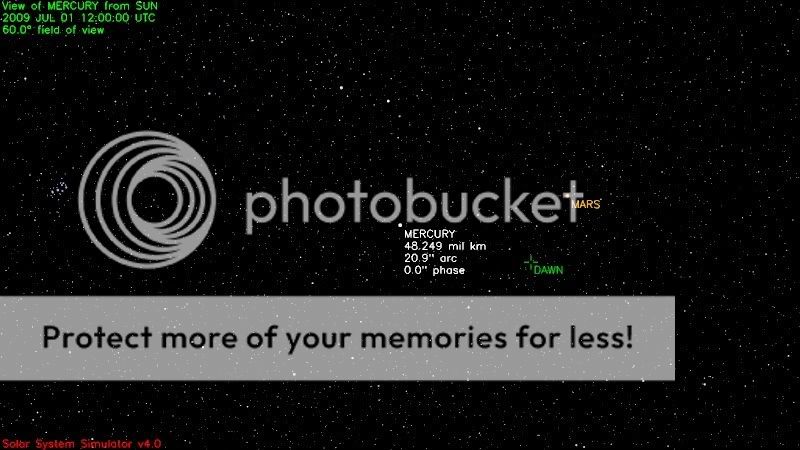
Venus (Aquarius).
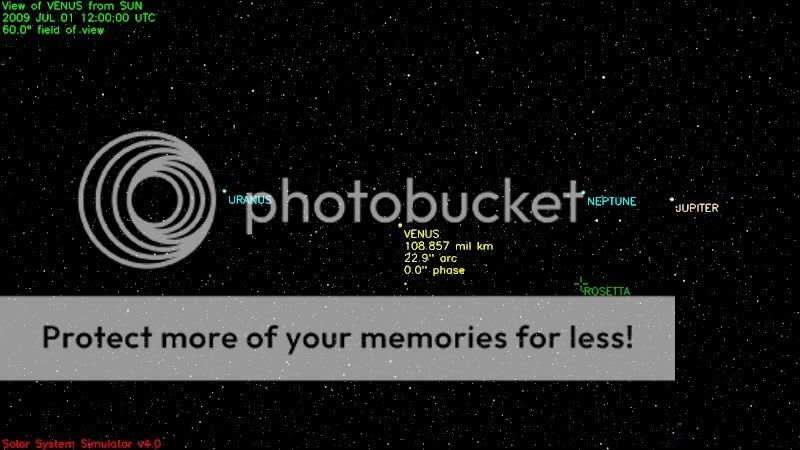
Earth & Moon (Sagittarius).

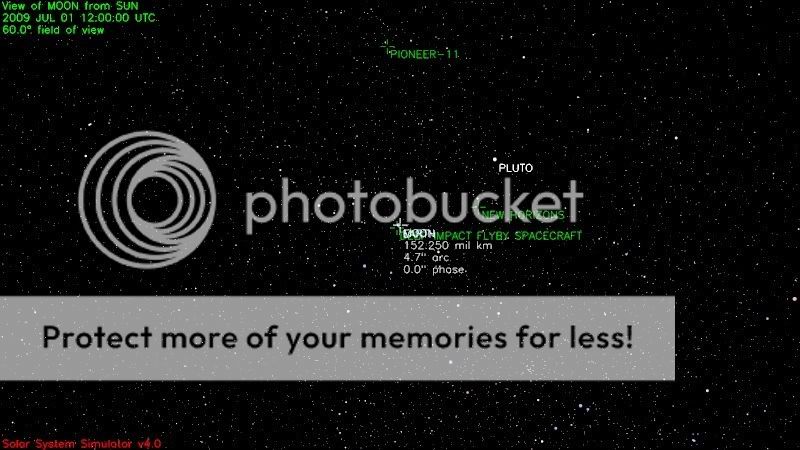
Mars (Pisces).
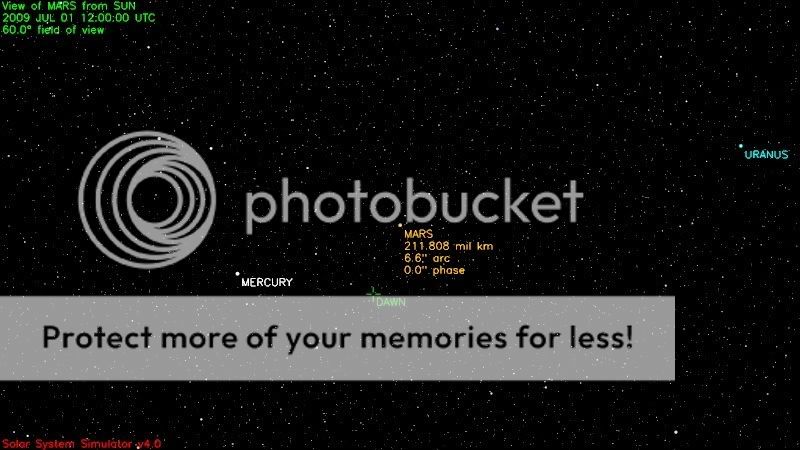
Jupiter (Capricornus).
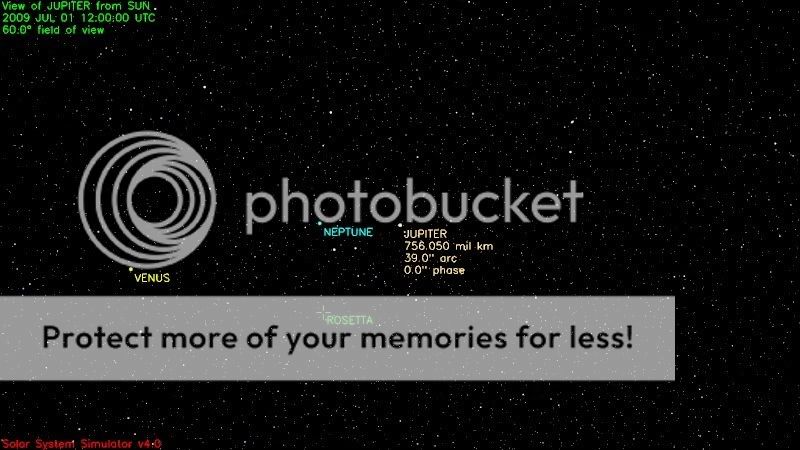
Saturn (Leo).
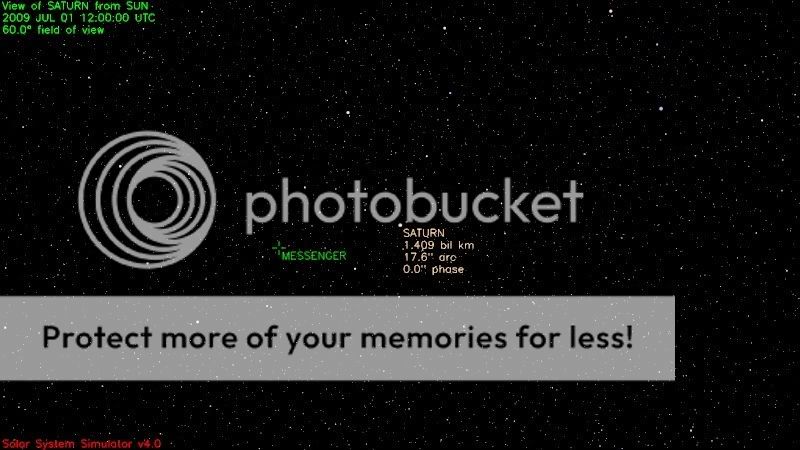
Uranus (Pisces).
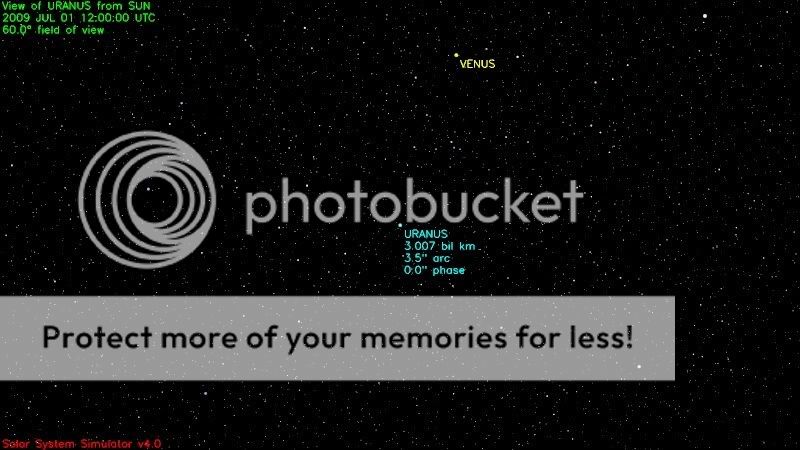
Neptune (Capricornus).
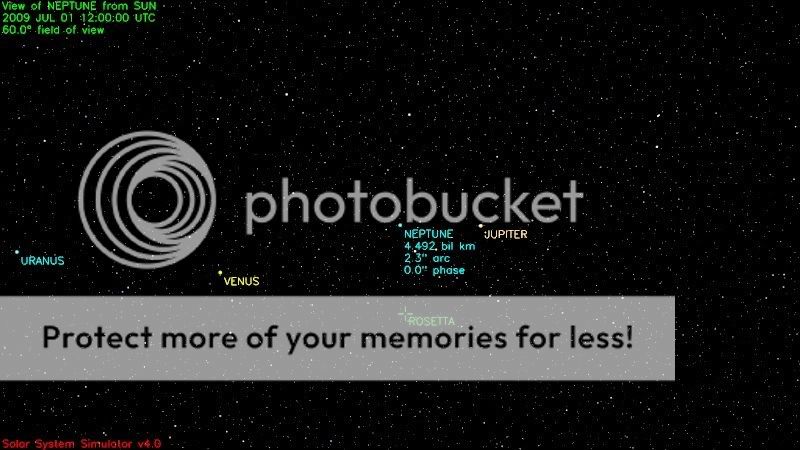
I've added a few a few spacecraft too.
Pioneer 10 (Taurus),
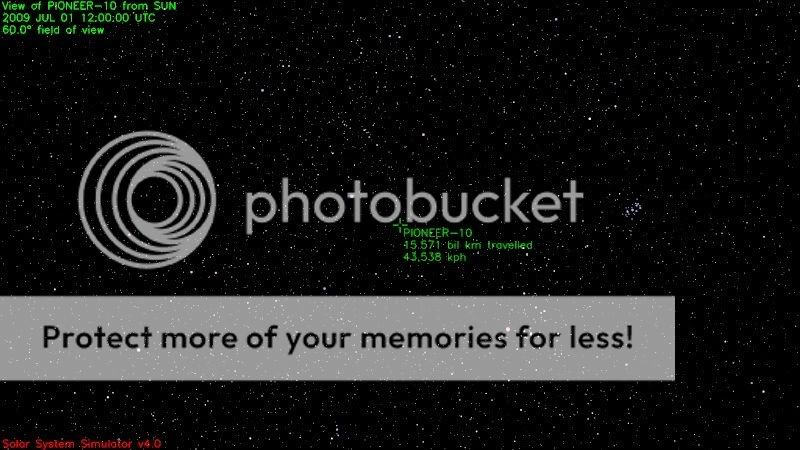
Pioneer 11 (Scutum).
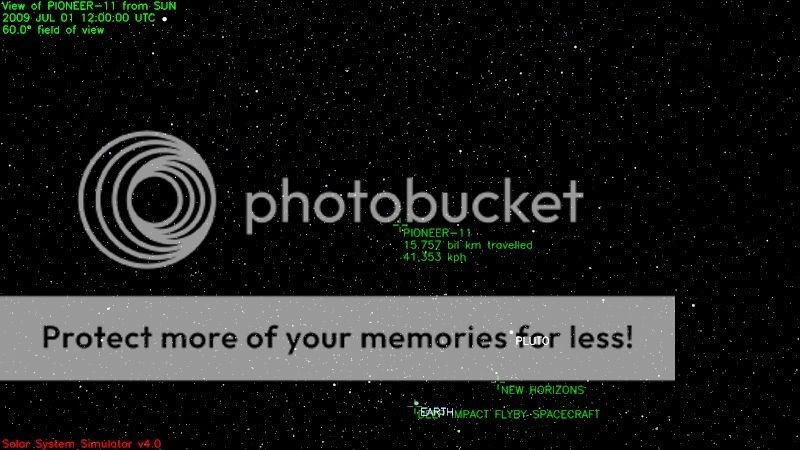
Voyager 1 (Ophiuchus).
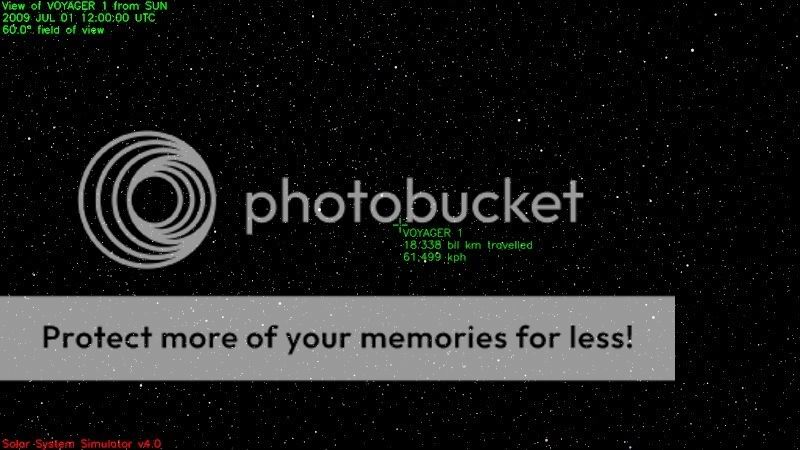
Voyager 2 (Telescopium).
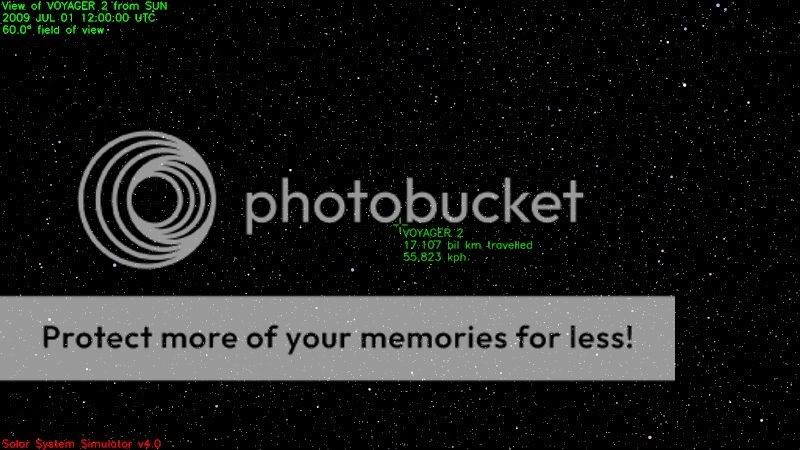
MESSENGER (Virgo).
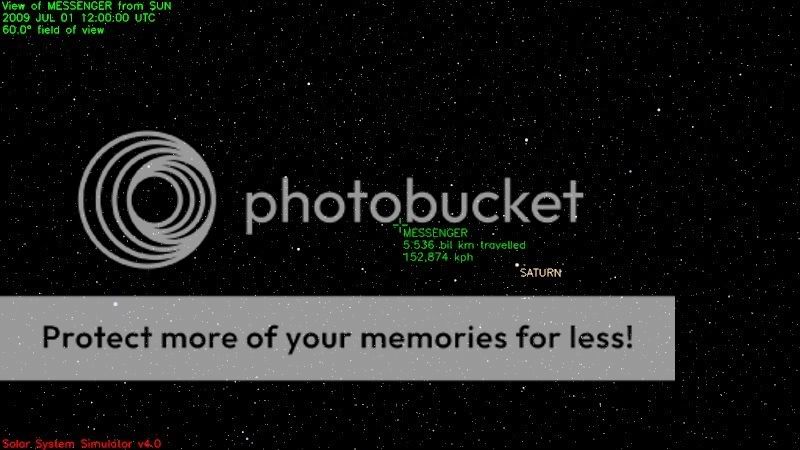
DAWN (Pisces).
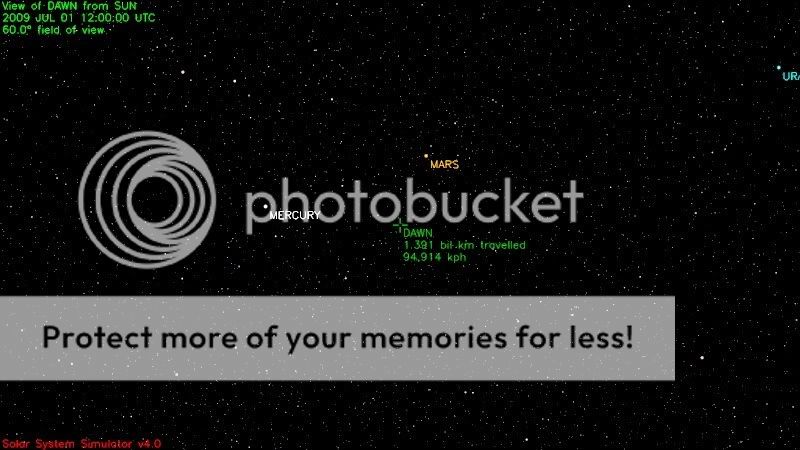
Andrew Brown.
Hi Silylene, your figures are pretty close. Well done.
I could not do a heliocentric view of the Solar System on Redshift, but have been able to do something using the NASA / JPL Solar System simulaotr. Planetary positions are shown as from the Sun as on: Wednesday 1st July 2009 @ 12:00 HRS UTC.
Constellations they appear in front of are in brackets.
Mercury (Cetus).

Venus (Aquarius).

Earth & Moon (Sagittarius).


Mars (Pisces).

Jupiter (Capricornus).

Saturn (Leo).

Uranus (Pisces).

Neptune (Capricornus).

I've added a few a few spacecraft too.
Pioneer 10 (Taurus),

Pioneer 11 (Scutum).

Voyager 1 (Ophiuchus).

Voyager 2 (Telescopium).

MESSENGER (Virgo).

DAWN (Pisces).

Andrew Brown.
S
silylene
Guest
3488":26cfgnki said:Hi Wayne, that's a good point regarding Earth.
Hi Silylene, your figures are pretty close. Well done.
Actually, for Mercury, Earth and Saturn, the apparent diameters could be darn near identical, depending on the planets' distance from the sun on their individual elliptical orbits. There is enough variation to make them overlap darn near exactly. And this would be interesting, especially if Mercury is occulting, since Mercury has no atmosphere.
Saturn would be interesting too, it is so non-spherical in shape it could not really be occulted that exactly, even if the apparent average planetary diameters were the same. And the rings would be cool...with Earth occulting in front of Saturn, then it would appear like Earth is a ringed planet!
I also thought it was interesting that that Moon appears larger than Uranus, and 75% the size of Mars.
3
3488
Guest
silylene":1fvyx0um said:3488":1fvyx0um said:Hi Wayne, that's a good point regarding Earth.
Hi Silylene, your figures are pretty close. Well done.
Actually, for Mercury, Earth and Saturn, the apparent diameters could be darn near identical, depending on the planets' distance from the sun on their individual elliptical orbits. There is enough variation to make them overlap darn near exactly. And this would be interesting, especially if Mercury is occulting, since Mercury has no atmosphere.
Saturn would be interesting too, it is so non-spherical in shape it could not really be occulted that exactly, even if the apparent average planetary diameters were the same. And the rings would be cool...with Earth occulting in front of Saturn, then it would appear like Earth is a ringed planet!
I also thought it was interesting that that Moon appears larger than Uranus, and 75% the size of Mars.
That's quite a thought Silylene regarding Mercury, Earth & Saturn, potentially some very interesting Sun based Astronomy, though that would be a hot topic (sorry for the crap joke).
A good point raised about the Moon not aopearing much smaller than Mars & appearing larger than Uranus, & Neptune.
The answer from my understanding is that the Moon is closer to the Sun than the other three, Uranus & Neptune being large planets are 3 billion & 4.5 billion KM away respectively so their considerably larger sizes are out gunned by their distances, where as the Moon is only 0.152 billion KM.
The Moon also is a reasonably large body in its own right, so being closer to the Sun than larger Mars, is enough to appear not that much smaller than Mars.
Andrew Brown.
- Status
- Not open for further replies.
Similar threads
- Replies
- 3
- Views
- 2K
- Replies
- 0
- Views
- 2K
- Replies
- 3
- Views
- 2K
- Replies
- 0
- Views
- 4K
TRENDING THREADS
-
New interpretation of QM, with new two-phase cosmology, solves 15 foundational problems in one go.
- Started by Geoff Dann
- Replies: 320
-
Hubble Tension explained (including its value) by the two phase cosmology
- Started by Geoff Dann
- Replies: 210
-
Basic Error: The accelerating Universe conclusion - reason
- Started by Gibsense
- Replies: 263
-
-
The birth of the Quantum Convergence Threshold (QCT):
- Started by Capanda Research
- Replies: 84
-
-

Space.com is part of Future plc, an international media group and leading digital publisher. Visit our corporate site.
© Future Publishing Limited Quay House, The Ambury, Bath BA1 1UA. All rights reserved. England and Wales company registration number 2008885.

